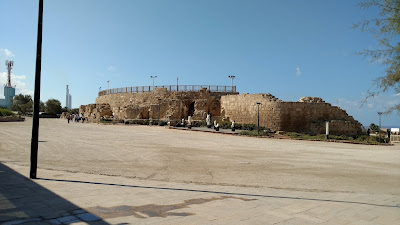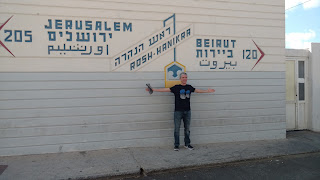 |
| Caesarea is a town in north-central Israel. Located midway between Tel Aviv
and Haifa
on the coastal plain near the city of Hadera. The town was built by Herod the
Great about 25–13 BCE as the port city Caesarea.
It served as an administrative center of Judaea
Province of the Roman Empire, and later the capital of the Byzantine
province during the classic period. Following the Muslim conquest in the 7th century, in
which it was the last city to fall to the Arabs, the city had an Arab majority
until Crusader conquest. It was abandoned after the Mamluk conquest. It was re-populated in 1884 by Bosniak
immigrants, who settled in a small fishing village. In 1952, a Jewish town of Caesarea was
established near the ruins of the old city, which were made into the national
park of Caesarea. |
 |
| North Coast of Israel near Rosh Hanikra |
 |
| Michael Standing at the border between Lebanon and Israel. Beirut is only 60 miles from the Israeli border. |
 |
Akko was
incorporated into the empire of Alexander the
Great after his conquest in 332 B.C.E. The city was subsequently
seized by the Egyptians until the Muslim
conquest in the 7th century CE, when its ancient name was restored.
Confusion over what to call the city was compounded by the Crusaders'
conquest in 1104, after which it became known as St. Jean d'Acre, or Acre
for short. In 1291, the Mamluks
invaded and destroyed the city, killing every remaining Crusader and putting an
end to the Latin Kingdom.
Acre
ceased to be a major city for almost 500 years. The Ottoman
Empire in the mid-18th century named the capital of Akko
his capital and built a large fortress. It was subsequently fortified by the
Turkish governor (1775-1804), Ahmad Pasha al-Jazzer ("The Butcher").
The mosque al-Jazzer built is one of the most beautiful in Israel and the most
distinctive building in the old city. Napoleon
landed in Palestine and assaulted Akko
in 1799, but he was unable to take the city. His Middle Eastern campaign
subsequently collapsed and he withdrew to France.
|
 |
Right outside, a tunnel leads out to the
Turkish Bazaar via a souvenir shop that was here long before the tunnel was
opened to the public.
|
 |
Courtyard of Khan al Omdan |










No comments:
Post a Comment